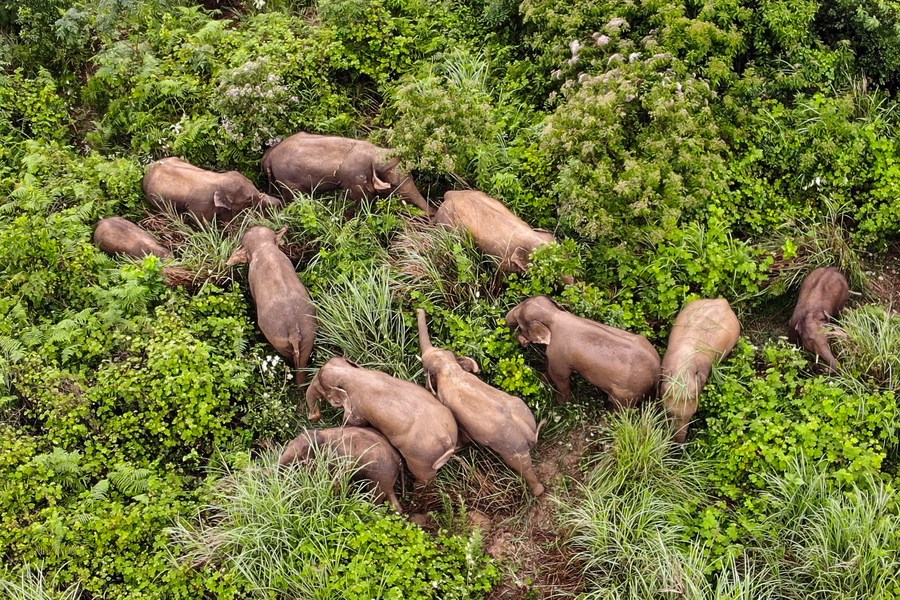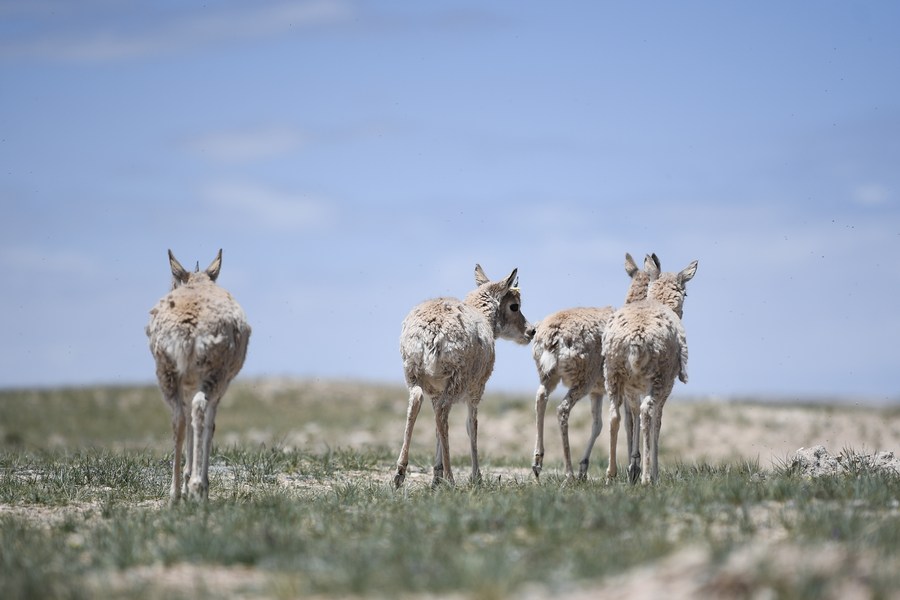China brings real, modern-day global example in biodiversity conservation, say e
 Aerial photo taken on Dec. 16, 2017 shows cherry trees on Wuliang Mountain in Nanjian Yi Autonomous County, southwest China's Yunnan Province.(Xinhua/Hu Chao)
Aerial photo taken on Dec. 16, 2017 shows cherry trees on Wuliang Mountain in Nanjian Yi Autonomous County, southwest China's Yunnan Province.(Xinhua/Hu Chao)
A report titled "The Hainan Gibbon Case Study: Effectively Saving a Critically Endangered Species" was released at the World Conservation Congress (WCC), which was running both online and in Marseille in southern France from Sept. 3 to 11.
From saving the rarest primate on Earth from the brink of extinction to escorting the epic adventure of wandering wild elephants through rainforest and jungle of concrete, China's contribution to biodiversity preservation has been widely applauded by ecologists.
Hainan gibbon, the most endangered of all gibbons, is endemic to the southern Chinese island of Hainan.
Dubbed as "Giant Panda of Hainan," Hainan gibbon is currently found only in a single reserve, the Bawangling Nature Reserve, part of the Hainan Tropical Rainforest National Park.
Earlier in March, the monitoring team found that two of the Hainan gibbon groups each added a baby ape, seven months old and six months old respectively, both in good health and growing well, bringing the population of Hainan gibbons from as few as seven to nine in the 1980s to five groups with a total of 35 individuals.
 Two adult Hainan gibbons, or Nomascus Hainanus, move on a tree in a nature reserve in Bawangling of south China's Hainan Province, Sept. 11, 2015. (Xinhua/Yang Guanyu)
Two adult Hainan gibbons, or Nomascus Hainanus, move on a tree in a nature reserve in Bawangling of south China's Hainan Province, Sept. 11, 2015. (Xinhua/Yang Guanyu)
On Sunday, a report titled "The Hainan Gibbon Case Study: Effectively Saving a Critically Endangered Species" was released at the World Conservation Congress (WCC), which was running both online and in Marseille in southern France from Sept. 3 to 11.
This case was "a very important example of how we can be successful in the conservation of highly threatened species," said Russell Mittermeier, chair of the Primate Specialist Group of the Species Survival Commission (SSC) of the International Union for Conservation of Nature (IUCN), which co-hosts the WCC Marseille with the French government.
Vance Martin, president of the U.S.-based WILD Foundation, told Xinhua that the protection of the Hainan gibbons was "a very remarkable example of practical conservation and international collaboration" and "a successful model that the world needs."
"The case is very special. Because of its extremely low number, this species should have been extincted, but it's not. Why? Because of really enlightened leadership, international cooperation and experts who really care," he told Xinhua.
 A woman walks past an earth-shaped pavilion during the 7th World Conservation Congress in Marseille, southern France, on Sept. 3, 2021. (Xinhua/Gao Jing)
A woman walks past an earth-shaped pavilion during the 7th World Conservation Congress in Marseille, southern France, on Sept. 3, 2021. (Xinhua/Gao Jing)
"And there is the unique way that the leadership enlisted the local community and the local community wanted to do it. So by doing these several distinct elements this species came back from the brink of extinction, and they are breeding strong now," he said.
The epic journey of wandering elephants in southwest China's Yunnan Province, which went viral on social media this summer, was also cited by many experts to illustrate China's success in preserving biodiversity.
Earlier this year, a herd of 14 wild Asian elephants -- a species under A-level protection in China -- strayed from their nature reserve. Heading north, they wandered some 500 km across southwest Yunnan Province before returning to their jungle paradise in August.
During the trip, the elephants crashed into people's houses, munched their crops and guzzled their water. Some 150,000 residents were evacuated, over 180 tonnes of food were provided to the "elephant tourist group" and many vehicles and drones were deployed to monitor and guide their way home.
 Aerial photo taken on Aug. 13, 2021 shows a herd of wild Asian elephants in Mojiang County of Pu'er City, southwest China's Yunnan Province. (Xinhua)
Aerial photo taken on Aug. 13, 2021 shows a herd of wild Asian elephants in Mojiang County of Pu'er City, southwest China's Yunnan Province. (Xinhua)
"Wherever the elephant herd went, people quietly gave way," said IUCN President Zhang Xinsheng in an interview with Xinhua. "Everyone, from villagers who let their crops get trampled or netizens who followed the live cam showed tolerance and love towards this endangered species."
"It was a vivid example of China's achievements in promoting the harmonious coexistence of humans and nature," he said.
Yunnan, nicknamed the "kingdom of plants and animals" for its rich biodiversity, has carried out over 120 conservation programs to rescue more than 100 endangered species including the Asian elephant and the Yunnan snub-nosed monkey.
These programs have increased the number of Asian elephants from 193 to 300 and the Yunnan snub-nosed monkeys from over 1,000 to over 3,300.
 Tibetan antelopes are released into the wild at a wildlife rescue center of the Sonam Dargye Protection Station in Hoh Xil, northwest China's Qinghai Province, July 7, 2021. (Xinhua/Zhang Long)
Tibetan antelopes are released into the wild at a wildlife rescue center of the Sonam Dargye Protection Station in Hoh Xil, northwest China's Qinghai Province, July 7, 2021. (Xinhua/Zhang Long)
The IUCN President also cited other cases in China, such as giant panda, whose vulnerability has been downgraded from "endangered" to "vulnerable" on the IUCN list, and Tibetan antelopes, downgraded from "endangered" to "nearly endangered".
"The downgrades on the Red List show an improvement in protection results," he said. "China has many successful cases."
Professor of ecology at the University of Franche-Comte, Patrick Giraudoux, who started working on biodiversity with Chinese colleagues since the 1990s, noted a huge upgrade of environmental awareness among the Chinese people.
"In the 1990s, wood could be cut quite freely but now protecting the environment and species has become a top priority in China," he said.
 An egret forages in the Minjiang River estuary nature reserve in southeast China's Fujian Province, April 20, 2021. (Xinhua/Wei Peiquan)
An egret forages in the Minjiang River estuary nature reserve in southeast China's Fujian Province, April 20, 2021. (Xinhua/Wei Peiquan)
Alexandre Ricard, Chairman and CEO of Pernod Ricard, one of France's major producers of wine and spirits and partner of the IUCN, told Xinhua that his company recently signed a partnership with the NGO Conservation International on the reforestation of mangroves on the Hailing Island in China's southern province of Guangdong.
"The relationship has been extremely positive," he said. "What I am seeing (in China) is a real awareness of our consumers and the general public in terms of pollution-fighting in particular."
Martin, a veteran expert of the IUCN on international nature conservation and wilderness protection, said that "China's example with eco-civilization is exactly what the world needs to do."
"If you look at what is happening with the new system of national parks in China, especially chosen to save not only animals but flora and fauna, nature conservation in China is a modern global example," said Martin, who has been to China many times.
 Dina (L) and Sofia display forest-themed cards made by themselves during the 7th World Conservation Congress (WCC) in Marseille, France, Sept. 4, 2021. (Xinhua/Gao Jing)
Dina (L) and Sofia display forest-themed cards made by themselves during the 7th World Conservation Congress (WCC) in Marseille, France, Sept. 4, 2021. (Xinhua/Gao Jing)
All provinces in China have drawn up "ecological red lines," and the zones demarcated by the "red lines" have a combined area of up to a quarter of the total land area of the country.
"By saving the wild habitat you are not only allowing the species to procreate on its own, but you are saving all the biodiversity and creating a climate and solution, you are basically creating and strengthening the production of life-supporting services for all life," said Martin.
"So there is a big picture story going on in China which is a real, modern-day global example of how you have to go about nature conservation," he said.